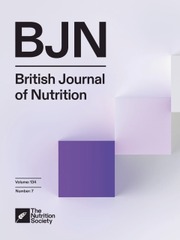Letter to the editor
Pillai et al. published in a recent issue a study titled, ‘Carotid intima medial thickness and its association with cardiometabolic risk factors in children with overweight and obesity: A hospital-based cross-sectional study’(Reference Sasidharan Pillai, Vijayakumar and Balakrishnan1). The study’s objective was to analyse the association of the carotid intima-media thickness (cIMT), an ultrasound surrogate marker for preclinical atherosclerosis, (i) in children with obesity and (ii) to compare children with elevated cIMT and normal cIMT(Reference Sasidharan Pillai, Vijayakumar and Balakrishnan1). The authors hypothesised that elevated cIMT will be found in children with higher obesity metabolic abnormalities than in children with normal cIMT(Reference Sasidharan Pillai, Vijayakumar and Balakrishnan1). 223 children aged 2–15 years were enrolled for the study. The majority of the study population were between 6 and 10 years of age (n 109, 48·9 %), males (n 139, 62·7 %) prepubertal (n 129, 57·8 %) and had obesity (n 180, 80·7 %)(Reference Sasidharan Pillai, Vijayakumar and Balakrishnan1). The cIMT was measured bilaterally at the common carotid artery(Reference Sasidharan Pillai, Vijayakumar and Balakrishnan1). The authors found no statistically significant correlations between cIMT and various clinical and cardiometabolic parameters. No predictors for cIMT were identified on linear regression analysis(Reference Sasidharan Pillai, Vijayakumar and Balakrishnan1). The authors concluded that ‘Our finding of elevated cIMT in nearly half of the study participants including young children is very concerning as these children are at increased risk of atherosclerotic cardiovascular disease in adulthood’(Reference Sasidharan Pillai, Vijayakumar and Balakrishnan1). Some comments are needed to evaluate the results and cIMT-related statements of this study(Reference Sasidharan Pillai, Vijayakumar and Balakrishnan1) in a more balanced way. The authors conceded that ‘Accuracy of cIMT measurement in young children may be limited by the relatively short neck compared to the length of the US transducer and the poor compliance’(Reference Sasidharan Pillai, Vijayakumar and Balakrishnan1). Given this major technical limitation, an exhaustive evaluation of the carotid artery is hampered. It is argued if at lower degrees of thickness and at early ages, the increased cIMT represents a true atherosclerotic burden, rather than hypertrophy of the intimal and medial layers(Reference Epure, Leyvraz and Mivelaz2). The pioneers in cIMT research, Bots et al., wrote in 1997 in one of their seminal papers, ‘Increased common carotid intima-media thickness. Adaptive response or a reflection of atherosclerosis?’, the following: Compared with other large arteries, however, atherosclerosis of the common carotid artery tends to develop relatively late in life…IMT of the common carotid artery is unlikely to represent local atherosclerosis… at lower degrees of IMT, the thickening may reflect an adaptive response to changes in shear stress, lumen diameter, tensile stress, and pressure instead of an atherosclerotic thickening’(Reference Bots, Hofman and Grobbee3).
The partial interrogation of the carotid artery (only the common carotid artery), although by some (outdated) guidelines recommended, will lead unavoidably to inaccurate reflection of the atherosclerotic burden in the investigated subjects. Pillai et al. furthermore did not mention if the cIMT measure was synchronised with the cardiac cycle(Reference Sasidharan Pillai, Vijayakumar and Balakrishnan1). The cIMT varies through the cardiac cycle reportedly by 30 μm, being thickest at end-diastole and thinnest at peak systole(Reference Drole Torkar, Plesnik and Groselj4). Pillai et al. (Reference Sasidharan Pillai, Vijayakumar and Balakrishnan1) did not report if cIMT measurement was synchronised, as recommended with the cardiac cycle (i.e. the end-diastolic phase), introducing a further important measurement bias. It is very likely, as a consequence of non-synchronisation, that for the same patient the left cIMT was measured in diastole (higher cIMT) and for the right cIMT measurement occurred in systole (lower cIMT). Consequently, the cIMT measures can neither be compared for the same subject nor between the subjects. However, equally within this context it is to consider that the heart rate in children is higher rendering it challenging to synchronise precisely with the end-diastolic phase. The reported mean values for cIMT of 0·41 ± 0·13 mm(Reference Sasidharan Pillai, Vijayakumar and Balakrishnan1) are within the normal range and are without diagnostic and prognostic values. In conclusion, the cIMT is a delicate surrogate marker as it is expressed at a sub-millimeter level (normal range e.g. less than 0.6 mm) and consequently the slightest inaccuracies suffice to misclassify subjects into different cIMT categories, from which equally (inaccurate) conclusions are deducted. In children, rather than performing cIMT measures, the assessment for atherosclerosis should be based on validated and reliable clinical and laboratory parameters such as BMI, blood pressure and cholesterol levels. Given these methodological flaws in the Pillai et al. study, the continuous absence of an international consensus as to the cIMT measurement protocol added by the intrinsic limitations of cIMT as a surrogate marker of preclinical atherosclerosis, the reported cIMT results and related conclusions by Pillai et al. should be analysed with caution(Reference Sasidharan Pillai, Vijayakumar and Balakrishnan1).
Acknowledgements
We thank Mrs Susanna Walker (USA) for her diligent proofreading of this manuscript for English language.
There was no funding.
No conflict of interests
Availability of data and materials: N/A
Ethics approval and consent to participate: N/A
Consent for publication: N/A



